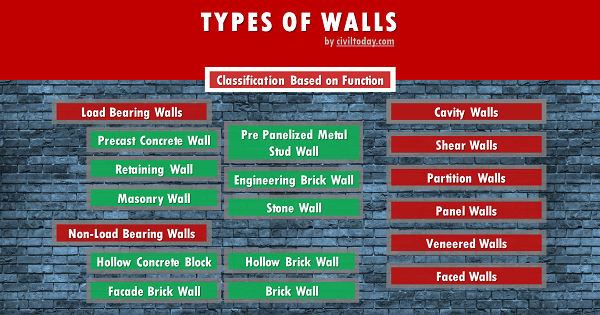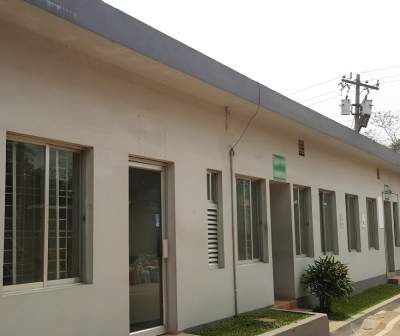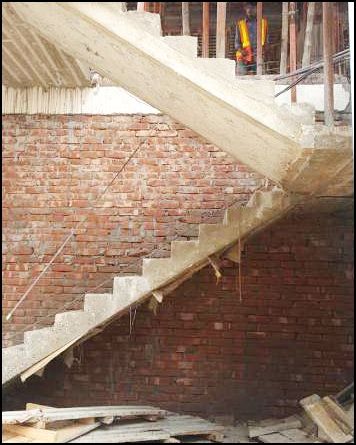Wall is a structure defining an exact area and providing safety & shelter. There are various types of walls used in the construction of buildings given below.
Types of Walls

- Load Bearing Walls
- Precast Concrete Wall
- Retaining Wall
- Masonry Wall
- Pre Panelized Load Bearing Metal Stud Walls
- Engineering Brick Wall
- Stone Wall
- Non-Load Bearing Wall
- Hollow Concrete Block
- Facade Bricks
- Hollow Bricks
- Brick Walls
- Cavity Walls
- Shear Walls
- Partition Walls
- Panel Walls
- Veneered Walls
- Faced Walls
Brief descriptions of different types of walls are given below.
Load Bearing Walls
Load bearing wall is a structural element. It carries the weight of a house from the roof and upper floors, all the way to the foundation. It supports structural members like beams(sturdy pieces of wood or metal), slab and walls on above floors above. A wall directly above the beam is called load bearing wall. It is designed to carry the vertical load. In another way, if a wall doesn’t have any walls, posts or other supports directly above it, it is more likely to be a load-bearing wall. Load bearing walls also carry their own weight. This wall is typically over one another on each floor. Load bearing walls can be used as interior or exterior wall. This kind of wall will often be perpendicular to floor joists or ridge. Concrete is an ideal material to support these loads. The beams go directly into the concrete foundation. Load bearing walls inside the house tend to run the same direction as the ridge.

Types of Load Bearing Walls:
- Precast Concrete Wall
- Retaining Wall
- Masonry Wall
- Pre Panelized Load Bearing Metal Stud Walls
- Engineering Brick Wall
- Stone Wall
Non-Load Bearing Walls
A wall which doesn’t help the structure to stand up and holds up only itself is known as a non-load bearing wall. It doesn’t support floor roof loads above. It is a framed structure. Most of the time, They are interior walls whose purpose is to divide the structure into rooms. They are built lighter. One can remove any non-load bearing walls without endangering the safety of the building. Non-load bearing walls can be identified by the joists and rafters. They are not responsible for gravitational support for the property. It is cost effective. This wall is referred to as “curtain wall”.

Types of Non-Load Bearing Wall:
- Hollow Concrete Block
- Facade Bricks
- Hollow Bricks
- Brick Walls
Cavity Walls
The cavity wall consists of two separate wythes. The wythes are made of masonry. Those two walls are known as internal leaf and external leaf. This wall is also known as a hollow wall. They reduce their weights on the foundation. They act as good as sound insulation. Cavity wall gives better thermal insulation than any other solid wall because space is full of air and reduces heat transmission. They have a heat flow rate that is 50 percent that of a solid wall. It is economically cheaper than other solid walls. It is fire resistant. Cavity wall helps to keep out from noise.
{adselite}
Shear Walls
It is a framed wall. It is designed to resist lateral forces. This lateral force comes from exterior walls, floor, and roofs to ground foundation. The usage of the shear wall is important, especially in large and high-rise buildings. It is typically constructed from materials like concrete or masonry. It has an excellent structural system to resist earthquakes. It provides stiffness in the direction. The construction and implementation are easy in shear walls. It is located symmetrically to reduce the ill effects of a twist. The shear wall doesn’t exhibit any stability problem.
Partition Walls
It is used in separating spaces from buildings. It can be solid, constructed from brick or stone. It is a framed construction. The partition wall is secured to the floor, ceiling, and walls. It is enough strong to carry its own load. It resists impact. It is stable and strong to support wall fixtures. The partition wall works as a sound barrier and it is fire resistant.
Panel Walls
It is a non-bearing wall between columns or pillars that are supported. The panel is installed with both nails and adhesive. The paneling design choices include rustic, boards, frame. Paneling can be from hardwoods or inexpensive pine. One should paint the space before installing panel walls.
Veneered Walls
With a veneered wall, we are holding up the material. It can be made of brick or stone. The most famous veneered wall is made of brick. The wall is only one wythe thick. It became the norm when building codes began to require insulation in the interior walls. It is light weighted. The construction takes less time to complete in veneered walls.
Faced Walls
It is a wall that masonry facing and backing are so bonded as to exert common action under load. It creates a streamlined look. The faced wall is easy to install.

